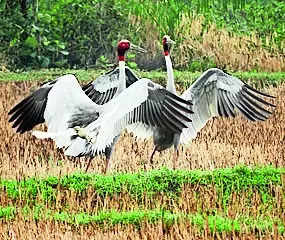What! Red Panda spotted in Lower Dibang valley of Arunachal Pradesh
etimes.in | Jun 29, 2024, 05.35 PM IST

A Red Panda (Ailurus fulgens) was recently spotted in the Lower Dibang Valley of Arunachal Pradesh, specifically within the Mehao Wildlife Sanctuary. This sighting, which occurred on June 27, 2024, marks a significant event as it is the first time the species has been camera-trapped in this sanctuary. The discovery was made by a team led by Dr. Kabuk Lego, the Range Forest Officer (RFO) of the area.The red panda was spotted in the Lower Dibang Valley through the use of 6 camera traps. This significant sighting occurred specifically in the Mayudia region and this effort was supported by the Wildlife Trust of India (WTI) based in Noida.

The Mehao Wildlife Sanctuary, spanning an area of 281.5 square kilometers, is known for its rich biodiversity and is home to various endangered species. The sanctuary’s diverse habitats, ranging from tropical evergreen forests to alpine meadows, provide an ideal environment for the Red Panda. These elusive creatures are primarily found in the temperate forests of the Himalayas, and their presence in Mehao highlights the ecological significance of this region.
Red Pandas are small mammals, slightly larger than a domestic cat, with a bear-like body and thick russet fur. They have distinctive white markings on their face and a bushy tail with alternating red and white rings. These animals are highly arboreal, spending most of their time in trees, and are known for their acrobatic abilities. Their diet mainly consists of bamboo, but they also eat fruits, acorns, and insects.
The sighting of the Red Panda in Lower Dibang Valley is particularly important given the species’ endangered status. According to the International Union for Conservation of Nature (IUCN), the global population of Red Pandas is estimated to be fewer than 10,000 individuals, with a declining trend due to habitat loss, poaching, and inbreeding depression. Conservation efforts are critical to ensure the survival of this species, and the recent sighting underscores the need for continued protection of their habitats.
The Mehao Wildlife Sanctuary has been a focal point for conservation activities in Arunachal Pradesh. The sanctuary’s management has implemented various measures to protect its wildlife, including anti-poaching patrols, habitat restoration projects, and community engagement programs. The camera-trapping of the Red Panda is part of a broader initiative to monitor and document the biodiversity of the sanctuary.
Dr. Lego and his team have been working tirelessly to raise awareness about the importance of conserving the Red Panda and other endangered species in the region. They have collaborated with local communities, government agencies, and non-governmental organizations to promote sustainable practices and reduce human-wildlife conflicts. Their efforts have been instrumental in enhancing the protection of the sanctuary’s unique flora and fauna.
The sighting of the Red Panda in Lower Dibang Valley has generated significant interest among wildlife enthusiasts and researchers. It highlights the sanctuary’s role as a critical habitat for endangered species and underscores the importance of continued conservation efforts.



The Mehao Wildlife Sanctuary, spanning an area of 281.5 square kilometers, is known for its rich biodiversity and is home to various endangered species. The sanctuary’s diverse habitats, ranging from tropical evergreen forests to alpine meadows, provide an ideal environment for the Red Panda. These elusive creatures are primarily found in the temperate forests of the Himalayas, and their presence in Mehao highlights the ecological significance of this region.
Red Pandas are small mammals, slightly larger than a domestic cat, with a bear-like body and thick russet fur. They have distinctive white markings on their face and a bushy tail with alternating red and white rings. These animals are highly arboreal, spending most of their time in trees, and are known for their acrobatic abilities. Their diet mainly consists of bamboo, but they also eat fruits, acorns, and insects.
The sighting of the Red Panda in Lower Dibang Valley is particularly important given the species’ endangered status. According to the International Union for Conservation of Nature (IUCN), the global population of Red Pandas is estimated to be fewer than 10,000 individuals, with a declining trend due to habitat loss, poaching, and inbreeding depression. Conservation efforts are critical to ensure the survival of this species, and the recent sighting underscores the need for continued protection of their habitats.
The Mehao Wildlife Sanctuary has been a focal point for conservation activities in Arunachal Pradesh. The sanctuary’s management has implemented various measures to protect its wildlife, including anti-poaching patrols, habitat restoration projects, and community engagement programs. The camera-trapping of the Red Panda is part of a broader initiative to monitor and document the biodiversity of the sanctuary.
Dr. Lego and his team have been working tirelessly to raise awareness about the importance of conserving the Red Panda and other endangered species in the region. They have collaborated with local communities, government agencies, and non-governmental organizations to promote sustainable practices and reduce human-wildlife conflicts. Their efforts have been instrumental in enhancing the protection of the sanctuary’s unique flora and fauna.
The sighting of the Red Panda in Lower Dibang Valley has generated significant interest among wildlife enthusiasts and researchers. It highlights the sanctuary’s role as a critical habitat for endangered species and underscores the importance of continued conservation efforts.
Houthis Go Berserk In Red Sea, Mediterranean; Ballistic Missiles 'Directly Hit' 4 Oil Tankers, Ships
03:17



